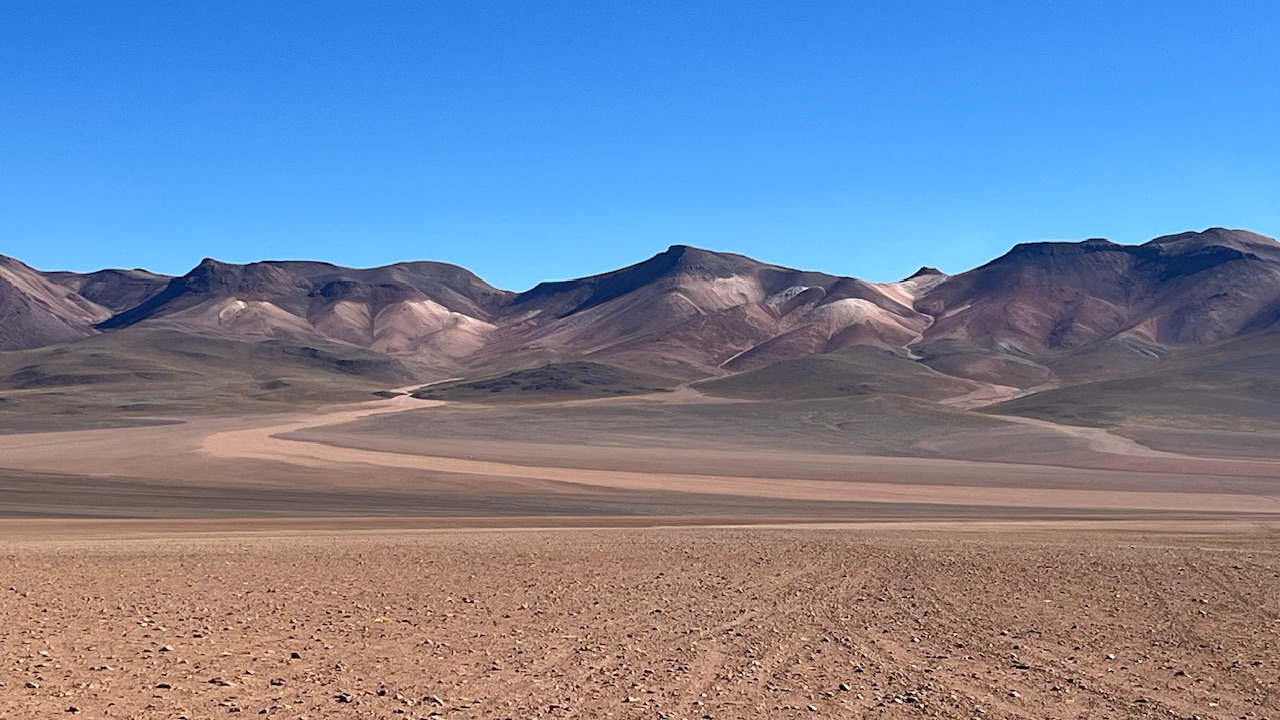Salar de Uyuni and desert lakes
The Salar de Uyuni is one of those bucket list type destinations, something so surreal you kind of have to see it to believe it. I had originally planned to see it by bike, cycling up from the Atacama desert, but because illness and reason getting the better of me, I had to settle for the 4×4 tour. Thank Christ I did. It’s easy to overestimate the quality of the roads when you’re in a massive offroad vehicle, but I’d say that 80% of the roads were awful, and water resources seemed extremely limited. So…my reluctant choice was validated to the extreme!
Anyway, the tour starts off with the Salar, a salt flat a little over 10,000 square kilometers in size. It’s huge. That’s why people come (and in droves), because it’s so big, you can literally lose sight of the horizon. An ocean of salt. I had three other lovely folks on my tour, and our guide coerced us into taking millions of the cliche (yet fun) forced-perspective shots that you see when you search for the place on the web

(I’m doing the handstand)
And of course, we had our shot at individual glory as well…

(Ride ‘em cowboy!)
Unfortunately the wind was (still) blowing like crazy, so we didn’t get great mirror-image effects or sunset shots. I wasn’t surprised, so I wasn’t disappointed.
After the Salar, we moved on to the traditional desert landscapes, wandering our way through SW Bolivia, up to the border with the Atacama desert and Chile. It’s difficult to describe the terrain as anything other than surreal, lunar, martian, etc., and photos don’t do the area justice, so you’ll just have to take my word for it. The plateau sits at about 4000m elevation, and though there are some 50+ volcanoes which pimple the landscape, signs of volcanic activity (like lava flows) are pretty few and far between. Indeed, the landscape is so smooth in places, it feels like it’s been poured from above.

(The out-of-place rocks are the only sign of an eruption you’ll find)


(Rumor has it, 1 liter of the red water you can’t see well in the photo has the equivalent amount of beta carotene as 600kg of carrots, which is also why the flamingos turn pink)
One highlight was jumping in 35C hotsprings at the 6am sunrise when it was -7C outside. Glorious.

Sucre is sweet
Quality language pun there. Sucre, turns out, is a UNESCO site for its preserved colonial city center. Also called “the white city”, both make sense when you visit.

(Note that for every street like this in Bolivia, there are 999 in which not a single wall is plastered or painted)
I thoroughly enjoyed my time there, spending a leisurely three days (with the exception of a two-hour bike ride through the hills) walking around and drinking coffee. It’s busy, but not chaotic; loud, but mostly from the hum of people or the random marching bands which seem to have occasion to play every day, rather than from the traffic. And on that note…I absolutely love the cars here. Tuning up cars is quite popular, so you’ll see early 90s Toyota Corolla wagons, lowered and with spoilers on them. So undeniably stupid, yet so clearly a sign of enthusiasm for life, and I’m here for it. Especially because it’s exactly what I wanted to do to the 92 Toyota Celica I inherited as my first car!
La Paz isn’t peaceful
A second language pun so bad and so cheap it really only deserves an eye roll. Anyway, La Paz is, well, not really my city, despite owning a few superlatives. It definitely has the coolest public transit in the world, with modern gondolas chauffeuring folks hither and thither above the city skyline. Which leads to the next superlative, which is that it is probably the most dramatically-staged city I’ve ever been to. Most of it lies in a valley at 3600m, but as the city grew, they started to build vertically up the 500m, 45-degree mountainsides that ring the city. Like the Italians did with their small medieval villages of a few thousand people, except La Paz has done it for a million folks. And if that weren’t impressive enough, you have 6000m+ snowcapped peaks at both the north and the south ends of the valley. It’s stunning. Not for nothing, my favorite part of the city was riding the gondolas and admiring the city from as many angles as possible.

Alas, that’s about all I found great about the city. What pedestrian-friendly streets do exist are sadly overrun by shops selling tourist kitsch or selling tours to nearby places like “The Death Road”, which I will cycle shortly with my full rig.
I do have to admit that I was exhausted on arrival, having slept only okay on an overnight bus from Sucre, so maybe with a fresher spirit I would have enjoyed the city more. Who knows. I’m certainly feeling the pace of my travels, and while I’m looking forward to the next couple of weeks at full-gas, I’m also looking forward to being stable in Lima for five days, surfing and relaxing (at least as is currently planned).
One overarching positive
I’ve loved the people. Their friendliness is not a neutral politeness, it’s got a warmth to it. Quite a few people have joked with me, whether I could understand it or not. The old cholita (more on that in a sec) figuratively holding my hand to get me on the right bus, the hotel manager giving me a hug as I depart for my next cycling trip, telling me to be safe and to call him if I need anything, or even the store clerk laughing while recommending another shop to visit to find what I’m looking for, but “Tomorrow. During the day. Right now it’s not safe for…uh…you. You know what I mean?”. Looking out, but having a laugh. I’m a fan of Bolivians, and Bolivia, even if La Paz doesn’t blow my skirt up.
Something you probably didn’t know
Some indigenous Bolivian women choose to dawn traditional garb and live by a specific set of standards; these women are called “cholitas”, meaning “little cholas”. This piqued my interest, because younger Mexican-American cultures also often refer to themselves as cholos or cholas (link is to a comedian’s spoof video). So what’s the common root, the etymology?
Well, turns out the Spanish are the problem. There are arguments over the specifics (one theory is that the word comes from a similar sounding name of the dog species Aztecs kept as pets, another has the term originating in Peru), but all versions agree that the conquistadores used the terms as a pejorative to describe indigenous or mestizo (mixed) peoples as dogs or at least as lower caste. While it’s quite cool that the cultures have more recently kind of “taken the term back”, and in Bolivia it’s seen in places as a point of pride, it apparently persists as a derogatory term in South America. Don’t know about the US, but you certainly won’t see me referring to any latinx people as cholos!

